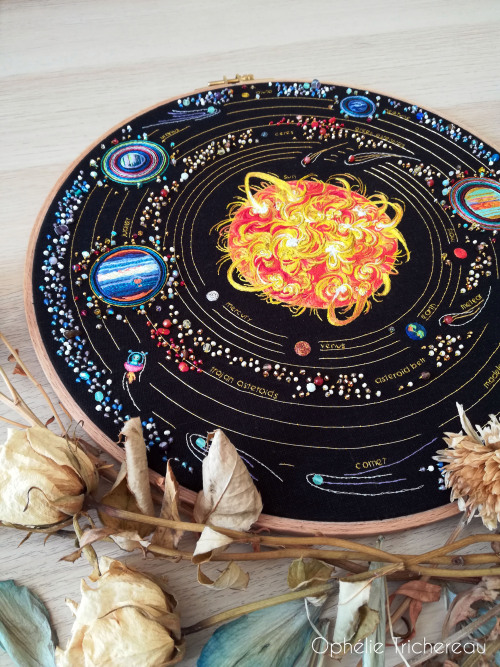IC 2087 Taurus Molecular Cloud © Nik Szymanek

IC 2087 Taurus Molecular Cloud © Nik Szymanek
More Posts from Ad-astra-affecte-spe and Others
Hey. Why isn’t the moon landing a national holiday in the US. Isn’t that fucked up? Does anyone else think that’s absurd?

Going for a walk. Apollo 17 astronaut Ronald Evans leaves to the spacecraft to retrieve film cassettes from the Service Module, Dec 1972. Mr. Evans was Command Module Pilot & orbited the moon a record 75 times during the mission. He holds the record for most time spent in lunar orbit at just shy of 148 hours. He is the last human to orbit the moon solo. A historic figure in space pioneering.

SPACEMAS DAY 2 ✨🪐🌎☄️☀️🌕
There's a new space telescope in the sky: Euclid. Equipped with two large panoramic cameras, Euclid captures light from the visible all the way to the near-infrared. It took five hours of observing for Euclid's 1.2-meter diameter primary mirror to capture, the 1000+ galaxies in the Perseus cluster which lies 250 million light years away. More than 100,000 galaxies are visible in the background, some as far away as 10 billion light years. Euclid's initial surveys, covering a third of the sky and recording over 2 billion galaxies, will enable a study of how dark matter and dark energy have shaped our universe.
Image Credit: ESA, NASA

Setting Sail to Travel Through Space: 5 Things to Know about our New Mission
Our Advanced Composite Solar Sail System will launch aboard Rocket Lab’s Electron rocket from the company’s Launch Complex 1 in Māhia, New Zealand no earlier than April 23, at 6 p.m. EDT. This mission will demonstrate the use of innovative materials and structures to deploy a next-generation solar sail from a CubeSat in low Earth orbit.
Here are five things to know about this upcoming mission:
1. Sailing on Sunshine
Solar sails use the pressure of sunlight for propulsion much like sailboats harness the wind, eliminating the need for rocket fuel after the spacecraft has launched. If all goes according to plan, this technology demonstration will help us test how the solar sail shape and design work in different orbits.

2. Small Package, Big Impact
The Advanced Composite Solar Sail System spacecraft is a CubeSat the size of a microwave, but when the package inside is fully unfurled, it will measure about 860 square feet (80 square meters) which is about the size of six parking spots. Once fully deployed, it will be the biggest, functional solar sail system – capable of controlled propulsion maneuvers – to be tested in space.

3. Second NASA Solar Sail in Space
If successful, the Advanced Composite Solar Sail System will be the second NASA solar sail to deploy in space, and not only will it be much larger, but this system will also test navigation capabilities to change the spacecraft’s orbit. This will help us gather data for future missions with even larger sails.

4. BOOM: Stronger, Lighter Booms
Just like a sailboat mast supports its cloth sails, a solar sail has support beams called booms that provide structure. The Advanced Composite Solar Sail System mission’s primary objective is to deploy a new type of boom. These booms are made from flexible polymer and carbon fiber materials that are stiffer and 75% lighter than previous boom designs. They can also be flattened and rolled like a tape measure. Two booms spanning the diagonal of the square (23 feet or about 7 meters in length) could be rolled up and fit into the palm of your hand!

5. It’s a bird...it’s a plane...it’s our solar sail!
About one to two months after launch, the Advanced Composite Solar Sail System spacecraft will deploy its booms and unfurl its solar sail. Because of its large size and reflective material, the spacecraft may be visible from Earth with the naked eye if the lighting conditions and orientation are just right!
To learn more about this mission that will inform future space travel and expand our understanding of our Sun and solar system, visit https://www.nasa.gov/mission/acs3/.
Make sure to follow us on Tumblr for your regular dose of space!

Perseverance: Drifting clouds just before sunrise on Mars (March 18, 2023)

Eruption of Tvashtar volcano on Jupiter's moon Io (March 1, 2007)
Y'all, the world is sleeping on what NASA just pulled off with Voyager 1
The probe has been sending gibberish science data back to Earth, and scientists feared it was just the probe finally dying. You know, after working for 50 GODDAMN YEARS and LEAVING THE GODDAMN SOLAR SYSTEM and STILL CHURNING OUT GODDAMN DATA.
So they analyzed the gibberish and realized that in it was a total readout of EVERYTHING ON THE PROBE. Data, the programming, hardware specs and status, everything. They realized that one of the chips was malfunctioning.
So what do you do when your probe is 22 Billion km away and needs a fix? Why, you just REPROGRAM THAT ENTIRE GODDAMN THING. Told it to avoid the bad chip, store the data elsewhere.
Sent the new code on April 18th. Got a response on April 20th - yeah, it's so far away that it took that long just to transmit.
And the probe is working again.
From a programmer's perspective, that may be the most fucking impressive thing I have ever heard.

Cosmic Dance of Spiral Galaxies: Arp 238
-
 frizwoa reblogged this · 1 month ago
frizwoa reblogged this · 1 month ago -
 wordsacrossspaceandtime liked this · 3 months ago
wordsacrossspaceandtime liked this · 3 months ago -
 demiaries reblogged this · 6 months ago
demiaries reblogged this · 6 months ago -
 ajpmagazine reblogged this · 6 months ago
ajpmagazine reblogged this · 6 months ago -
 willgrahamgenderenvy liked this · 6 months ago
willgrahamgenderenvy liked this · 6 months ago -
 rosecoloredray liked this · 6 months ago
rosecoloredray liked this · 6 months ago -
 princelycosmos reblogged this · 6 months ago
princelycosmos reblogged this · 6 months ago -
 goendlessspace liked this · 6 months ago
goendlessspace liked this · 6 months ago -
 ouranien reblogged this · 6 months ago
ouranien reblogged this · 6 months ago -
 rubiesoferebor liked this · 8 months ago
rubiesoferebor liked this · 8 months ago -
 staystrongahavefaith reblogged this · 9 months ago
staystrongahavefaith reblogged this · 9 months ago -
 greywolf117 reblogged this · 9 months ago
greywolf117 reblogged this · 9 months ago -
 greywolf117 liked this · 9 months ago
greywolf117 liked this · 9 months ago -
 jasshands liked this · 9 months ago
jasshands liked this · 9 months ago -
 skarlettriott reblogged this · 10 months ago
skarlettriott reblogged this · 10 months ago -
 mara liked this · 10 months ago
mara liked this · 10 months ago -
 spacehuntress2 reblogged this · 11 months ago
spacehuntress2 reblogged this · 11 months ago -
 indigo-----soul reblogged this · 11 months ago
indigo-----soul reblogged this · 11 months ago -
 leyla2508 liked this · 11 months ago
leyla2508 liked this · 11 months ago -
 no-name-blog92 liked this · 11 months ago
no-name-blog92 liked this · 11 months ago -
 stellarskyes reblogged this · 11 months ago
stellarskyes reblogged this · 11 months ago -
 spacehuntress2 liked this · 11 months ago
spacehuntress2 liked this · 11 months ago -
 cor-serpentis reblogged this · 11 months ago
cor-serpentis reblogged this · 11 months ago -
 cor-serpentis liked this · 11 months ago
cor-serpentis liked this · 11 months ago -
 bigearedguy reblogged this · 11 months ago
bigearedguy reblogged this · 11 months ago -
 bigearedguy liked this · 11 months ago
bigearedguy liked this · 11 months ago -
 atamaris-art liked this · 11 months ago
atamaris-art liked this · 11 months ago -
 atamaris-art reblogged this · 11 months ago
atamaris-art reblogged this · 11 months ago -
 holisticleaf liked this · 11 months ago
holisticleaf liked this · 11 months ago -
 silv3rclouds liked this · 11 months ago
silv3rclouds liked this · 11 months ago -
 lightcycler reblogged this · 11 months ago
lightcycler reblogged this · 11 months ago -
 lightcycler liked this · 11 months ago
lightcycler liked this · 11 months ago -
 thelostredunicorn reblogged this · 11 months ago
thelostredunicorn reblogged this · 11 months ago -
 thelostredunicorn liked this · 11 months ago
thelostredunicorn liked this · 11 months ago -
 paid-in-drugs-and-gold reblogged this · 11 months ago
paid-in-drugs-and-gold reblogged this · 11 months ago -
 silv3rclouds reblogged this · 11 months ago
silv3rclouds reblogged this · 11 months ago -
 kmc1989 reblogged this · 11 months ago
kmc1989 reblogged this · 11 months ago -
 kmc1989 liked this · 11 months ago
kmc1989 liked this · 11 months ago -
 daddy-issues-galore liked this · 11 months ago
daddy-issues-galore liked this · 11 months ago -
 sarahdonald87 reblogged this · 11 months ago
sarahdonald87 reblogged this · 11 months ago -
 sarahdonald87 liked this · 11 months ago
sarahdonald87 liked this · 11 months ago -
 inshelliesworld reblogged this · 11 months ago
inshelliesworld reblogged this · 11 months ago -
 simplyylana reblogged this · 11 months ago
simplyylana reblogged this · 11 months ago -
 neonsdeath liked this · 11 months ago
neonsdeath liked this · 11 months ago

★•Astronomy, Physics, and Aerospace•★ Original and Reblogged Content curated by a NASA Solar System Ambassador
204 posts









